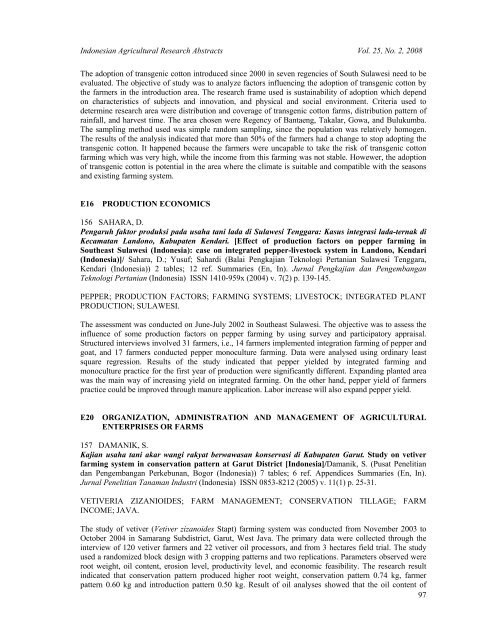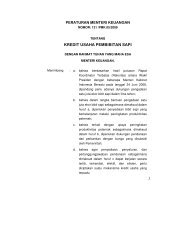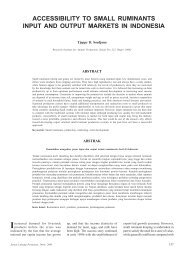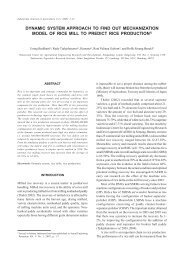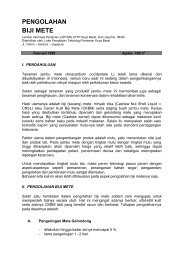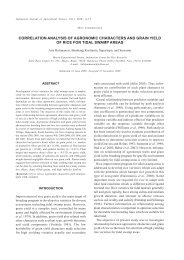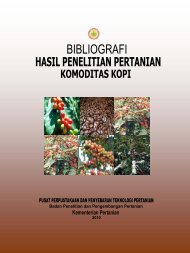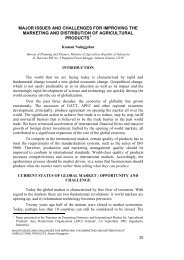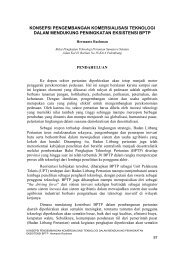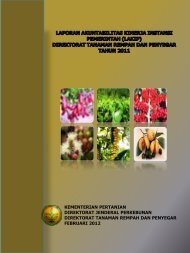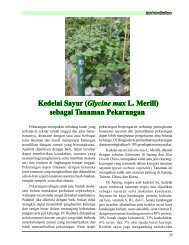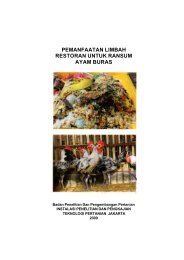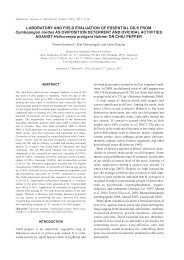<strong>Vol</strong>. 25, <strong>No</strong>. 2, <strong>2008</strong>Indonesian Agricultural Research Abstractsthe proper terrace arrangement. <strong>Th</strong>e objective of this study was to obtain terrace arrangement models andfodder composition. Assessment was conducted at Malang Experimental Farm from January to December2002 at the altitude of 500 m asl, on agroecology zone IV ax li. <strong>Th</strong>is research was directed at terracearrangement and fodder composition to support land conservation and forages. Assessment was set in arandomized split plot design with 3 replications. Terrace type was the main plot, there were bench andridge terrace. <strong>Th</strong>e submain plot was legumes as a reinforcement terrace, using Flemingia, Leucaena,Gliricidia and Calliandra, and control without reinforcement terrace plant. At the beginning, the Leucaenagrowth was better than others, especially on the ridge terrace, but on the conservation side, Gliricidia andFlemingia had the canopy and wide leaves, and could reduce the rainfall that caused erosion.E14DEVELOPMENT ECONOMICS AND POLICIES154 MURTIYENIPerilaku komunikasi dan persepsi peternak terhadap proses pengambilan keputusan inovasi teknologiternak domba/kambing di Kabupaten Purwakarta dan Majalengka. Communication behaviour andfarmer's perception toward decision making of technology innovation at sheep/goat rearing inPurwakarta and Majalengka District/Murtiyeni; Priyanto, D.; Yulistiani, D.; Isbandi (Balai PenelitianTernak, Bogor (Indonesia)); Hanafiah, A. 6 tables; 17 ref. Summaries (En, In). [Proceedings of thenational seminar on livestock and veterinary in 2004. Book 1]. Prosiding seminar nasional teknologipeternakan dan veteriner 2004. Buku 1/<strong>Th</strong>alib, A.; Sendow, I.; Purwadaria, T.; Tarmudji; Darmono;Triwulanningsih, E.; Beriajaya; Natalia, L.; Nurhayati; Ketaren, P.P.; Priyanto, D.; Iskandar, S.; Sani, Y.(eds.); Pusat Penelitian dan Pengembangan Peternakan, Bogor (Indonesia). Bogor: Puslitbangnak, 2004: p.323-334.SHEEP; GOATS; TECHNOLOGY TRANSFER; INNOVATION; FARMERS; DIFFUSION OFINFORMATION; JAVA.Agricultural communication is one of the important things on the outcome of adoption innovation process.<strong>Th</strong>e lack of technology innovation causes users doubt or refuse kind of innovation. <strong>Th</strong>e research wasdesigned: (1) to compare communication behavior and farmer's perception toward innovation technologiesat two research locations, (2) to explain adoption technologies processes which were introduced, and (3) toidentify the factors which correlated with adoption of innovation and correlation among the factors. <strong>Th</strong>isresearch was conducted by survey methods in January 2003 at sheep/goat farmers which were introducedinnovation technologies and guided for 6 months. Population sampling was observed using Mann Whitneymethods and rank Spearman was used to analyze data. <strong>Th</strong>e result indicated that: (1) communicationbehavior (discussing information, meeting attendance, social participation) was not significantly different,(2) farmer's perception toward innovation technologies (profitability, compatability, complexity, triabilityand observability) were not significantly different, generally farmers had high score perception, (3)adoption of innovation processes (knowledge, persuasion, decision and confirmation) generally showedhigh score, except stable technology indicated low adoption, (4) behavior communication factors(cosmopolitant, mass media possesion and social participation) in Majalengka District significantly relatedwith confirmation technologies, while in Purwakarta District, the mass media possesion relatedsignificantly with confirmation technologies. Farmer's perception (compatability and triability) inPurwakarta District related significantly with confirmation level of innovation technologies.155 WAHYUDI, A.Analisis keberlanjutan adopsi kapas transgenik di Sulawesi Selatan. Analysis of sustainability oftransgenic cotton adoption in South Sulawesi (Indonesia)/Wahyudi, A.; Taher, S. (Pusat Penelitian danPengembangan Perkebunan, Bogor (Indonesia)); Wati, R. 1 ill., 2 tables; 9 ref. Summaries (En, In).Jurnal Penelitian Tanaman Industri (Indonesia) ISSN 0853-8212 (2003) v. 9(4) p. 135-140.GOSSYPIUM HIRSUTUM; TRANSGENIC PLANTS; FARMING SYSTEMS; FARM INCOME;INNOVATION ADOPTION; SULAWESI.96
Indonesian Agricultural Research Abstracts <strong>Vol</strong>. 25, <strong>No</strong>. 2, <strong>2008</strong><strong>Th</strong>e adoption of transgenic cotton introduced since 2000 in seven regencies of South Sulawesi need to beevaluated. <strong>Th</strong>e objective of study was to analyze factors influencing the adoption of transgenic cotton bythe farmers in the introduction area. <strong>Th</strong>e research frame used is sustainability of adoption which dependon characteristics of subjects and innovation, and physical and social environment. Criteria used todetermine research area were distribution and coverage of transgenic cotton farms, distribution pattern ofrainfall, and harvest time. <strong>Th</strong>e area chosen were Regency of Bantaeng, Takalar, Gowa, and Bulukumba.<strong>Th</strong>e sampling method used was simple random sampling, since the population was relatively homogen.<strong>Th</strong>e results of the analysis indicated that more than 50% of the farmers had a change to stop adopting thetransgenic cotton. It happened because the farmers were uncapable to take the risk of transgenic cottonfarming which was very high, while the income from this farming was not stable. Howewer, the adoptionof transgenic cotton is potential in the area where the climate is suitable and compatible with the seasonsand existing farming system.E16PRODUCTION ECONOMICS156 SAHARA, D.Pengaruh faktor produksi pada usaha tani lada di Sulawesi Tenggara: Kasus integrasi lada-ternak diKecamatan Landono, Kabupaten Kendari. [Effect of production factors on pepper farming inSoutheast Sulawesi (Indonesia): case on integrated pepper-livestock system in Landono, Kendari(Indonesia)]/ Sahara, D.; Yusuf; Sahardi (Balai Pengkajian Teknologi Pertanian Sulawesi Tenggara,Kendari (Indonesia)) 2 tables; 12 ref. Summaries (En, In). Jurnal Pengkajian dan PengembanganTeknologi Pertanian (Indonesia) ISSN 1410-959x (2004) v. 7(2) p. 139-145.PEPPER; PRODUCTION FACTORS; FARMING SYSTEMS; LIVESTOCK; INTEGRATED PLANTPRODUCTION; SULAWESI.<strong>Th</strong>e assessment was conducted on June-July 2002 in Southeast Sulawesi. <strong>Th</strong>e objective was to assess theinfluence of some production factors on pepper farming by using survey and participatory appraisal.Structured interviews involved 31 farmers, i.e., 14 farmers implemented integration farming of pepper andgoat, and 17 farmers conducted pepper monoculture farming. Data were analysed using ordinary leastsquare regression. Results of the study indicated that pepper yielded by integrated farming andmonoculture practice for the first year of production were significantly different. Expanding planted areawas the main way of increasing yield on integrated farming. On the other hand, pepper yield of farmerspractice could be improved through manure application. Labor increase will also expand pepper yield.E20 ORGANIZATION, ADMINISTRATION AND MANAGEMENT OF AGRICULTURALENTERPRISES OR FARMS157 DAMANIK, S.Kajian usaha tani akar wangi rakyat berwawasan konservasi di Kabupaten Garut. Study on vetiverfarming system in conservation pattern at Garut District [Indonesia]/Damanik, S. (Pusat Penelitiandan Pengembangan Perkebunan, Bogor (Indonesia)) 7 tables; 6 ref. Appendices Summaries (En, In).Jurnal Penelitian Tanaman Industri (Indonesia) ISSN 0853-8212 (2005) v. 11(1) p. 25-31.VETIVERIA ZIZANIOIDES; FARM MANAGEMENT; CONSERVATION TILLAGE; FARMINCOME; JAVA.<strong>Th</strong>e study of vetiver (Vetiver zizanoides Stapt) farming system was conducted from <strong>No</strong>vember 2003 toOctober 2004 in Samarang Subdistrict, Garut, West Java. <strong>Th</strong>e primary data were collected through theinterview of 120 vetiver farmers and 22 vetiver oil processors, and from 3 hectares field trial. <strong>Th</strong>e studyused a randomized block design with 3 cropping patterns and two replications. Parameters observed wereroot weight, oil content, erosion level, productivity level, and economic feasibility. <strong>Th</strong>e research resultindicated that conservation pattern produced higher root weight, conservation pattern 0.74 kg, farmerpattern 0.60 kg and introduction pattern 0.50 kg. Result of oil analyses showed that the oil content of97
- Page 2: ISSN: 0216-3713INDONESIAN AGRICULTU
- Page 9 and 10: Indonesian Agricultural Research Ab
- Page 11 and 12: Indonesian Agricultural Research Ab
- Page 13 and 14: Indonesian Agricultural Research Ab
- Page 15 and 16: Indonesian Agricultural Research Ab
- Page 17 and 18: Indonesian Agricultural Research Ab
- Page 19 and 20: Indonesian Agricultural Research Ab
- Page 21 and 22: Indonesian Agricultural Research Ab
- Page 23 and 24: Indonesian Agricultural Research Ab
- Page 25 and 26: Indonesian Agricultural Research Ab
- Page 27 and 28: Indonesian Agricultural Research Ab
- Page 29 and 30: Indonesian Agricultural Research Ab
- Page 31 and 32: Indonesian Agricultural Research Ab
- Page 33 and 34: Indonesian Agricultural Research Ab
- Page 35 and 36: Indonesian Agricultural Research Ab
- Page 37 and 38: Indonesian Agricultural Research Ab
- Page 39 and 40: Indonesian Agricultural Research Ab
- Page 41 and 42: Indonesian Agricultural Research Ab
- Page 43 and 44: Indonesian Agricultural Research Ab
- Page 45 and 46: Indonesian Agricultural Research Ab
- Page 47 and 48: Indonesian Agricultural Research Ab
- Page 49 and 50: Indonesian Agricultural Research Ab
- Page 51 and 52: Indonesian Agricultural Research Ab
- Page 53 and 54:
Indonesian Agricultural Research Ab
- Page 55 and 56:
Indonesian Agricultural Research Ab
- Page 57 and 58:
Indonesian Agricultural Research Ab
- Page 59 and 60:
Indonesian Agricultural Research Ab
- Page 61 and 62:
Indonesian Agricultural Research Ab
- Page 63 and 64:
Indonesian Agricultural Research Ab
- Page 65 and 66:
Indonesian Agricultural Research Ab
- Page 67 and 68:
Indonesian Agricultural Research Ab
- Page 69 and 70:
Indonesian Agricultural Research Ab
- Page 71 and 72:
Indonesian Agricultural Research Ab
- Page 73 and 74:
Indonesian Agricultural Research Ab
- Page 75 and 76:
Indonesian Agricultural Research Ab
- Page 77 and 78:
Indonesian Agricultural Research Ab
- Page 79 and 80:
Indonesian Agricultural Research Ab
- Page 81 and 82:
Vol. 25, No. 2, 2008BODY WEIGHT251,
- Page 83 and 84:
Vol. 25, No. 2, 2008EVALUATION210EX
- Page 85 and 86:
Vol. 25, No. 2, 2008LACTUCA SATIVA1
- Page 87 and 88:
Vol. 25, No. 2, 2008PROPAGATION MAT
- Page 89 and 90:
Vol. 25, No. 2, 2008VVANILLA PLANIF


